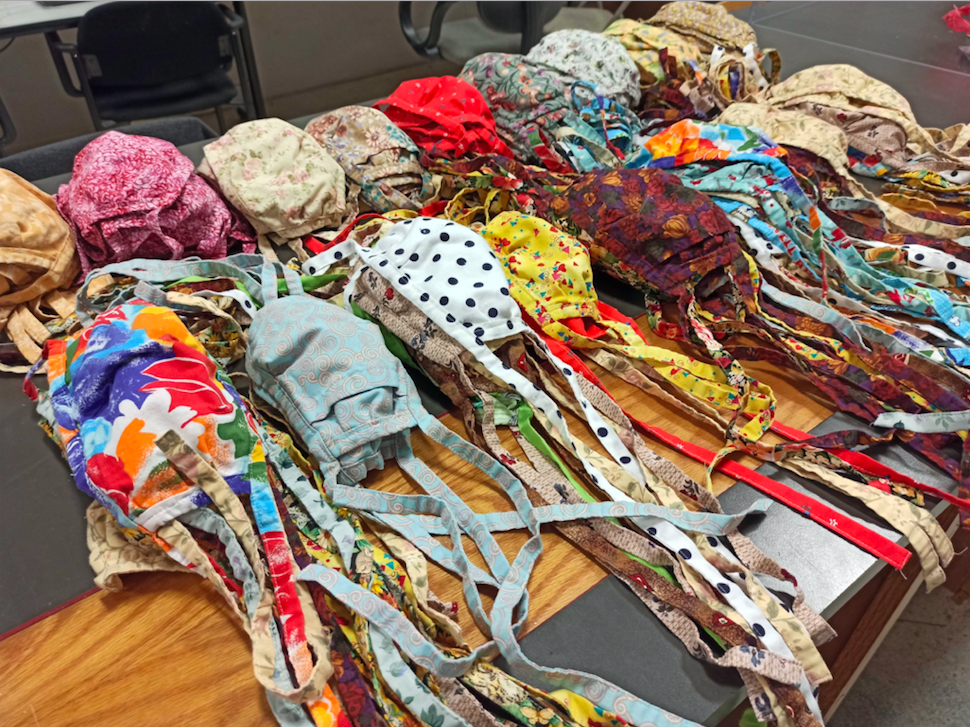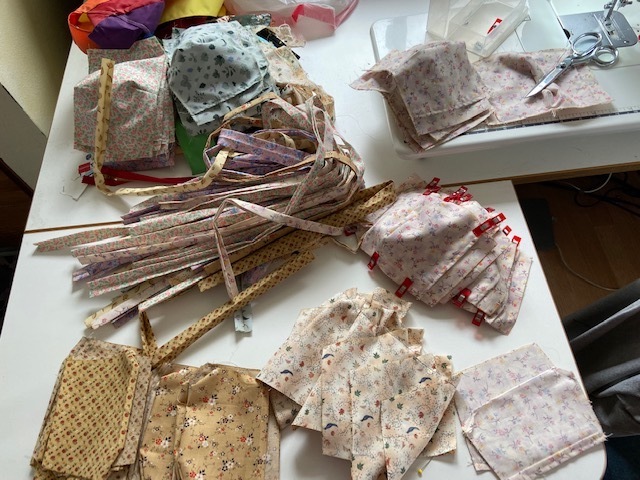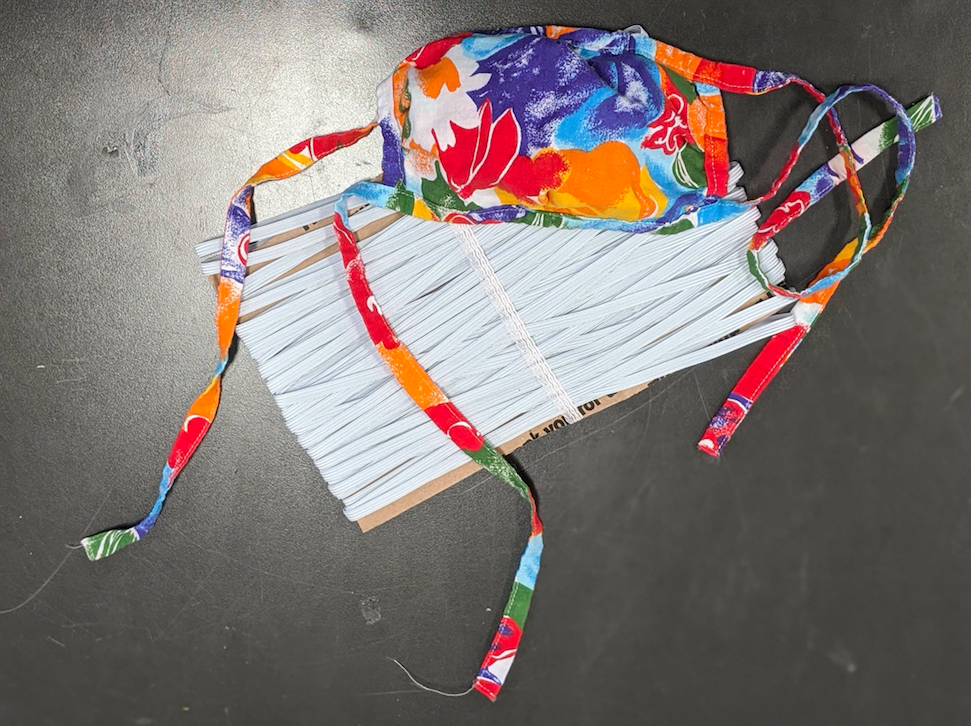
Mass Making Masks
How Lasercut Fabric Ramps Up The Process
It’s been two months since Ethan Berkowitz’s “Hunker Down” order across Anchorage, and the development of PPE for first responders, essential workers, and immuno-compromised citizens has been slowly gaining momentum.
For the Maker community, however, there’s been little time to wait.
Anchorage Makerspace members have always been at the forefront of innovation. Our efforts in tackling this novel pandemic, alongside some incredible community members mentioned further along, continue to adapt. We wouldn’t be anywhere without the Anchorage community reaching out to us to show us that there is a huge need for prototyping, testing, and producing PPE.
The Laser Sewing Mask Master
3 years ago, Sue Davis attended Anchorage Makerspace’s Intro To Laser Cutting class, and a seed was planted. Upon discovering the capabilities of the machine, she signed on as a member, ready to learn.
As soon as she was onboarded, the laser cutter was her full focus. As a seamstress, she was interested in how far she could stretch the machine’s abilities, including cutting fabric for quilts, bags, and clothing.
She quickly became known as the Laser Sewing Master.

Why take mask making into our own hands?
Naturally, when faced with the ever-growing problem of the lack of surgically-sound masks and those creating them, Sue decided to take part.
There were already some amazing community efforts being coordinated—specifically the four focused women behind Alaska Mask Makers—and knew that her skills could really ramp up production for the Mask Makers and herself.
As the “Hunker Down” order took place and sewing shops were slowly closing, materials became harder to obtain. Ordering them in wasn’t an immediate solution.
Without elastic and factory-produced masks to take inspiration from, it became quickly obvious Sue was going to need to create her own solution.
Creative solutions aren’t perfect—but neither is waiting around.
It’s important to mention that these masks are not surgically approved. The solution is a creatively-driven response to a novel problem and therefore, cannot be supplemented as surgically-sound equipment.
That being said, there are many benefits to this solution:
- These masks are designed to fit over an N95 mask, therefore extending the life of the original PPE.
- The design creates a pocket where surgical wrap and/or filter material can be added, upgrading the mask from a standard cloth design.
- The masks are elastic-less, making them a great alternative for those with latex or other microplastic/rubber allergies.
- The masks can fit a variety of faces due to their tying fixture and can be easily adjusted if necessary with longer or shorter fabric ties.
- By using cloth materials, the masks still reduce large microparticle spread, making them a better option than a bandana or nothing at all.
- They are washable, reusable, and therefore, sustainable.
With every community-driven solution, there will be benefits and downfalls. It is up to us all to make sound decisions for ourselves and our families, and for the bettering of the whole community.

Anchorage Makerspace steps in and steps up the project!
Before Sue could do any cutting, sewing, or ironing, she needed to have a plan.
With everybody at home in quarantine, there is lots of misinformation being spread, thus a lot of research was the first step. We’ll cover more about the design Sue decided on later in this blog, but here are the tools she ended up needing to complete the project:
- Hundreds of yards of fabric
- A 100W laser cutter with a 4’x3′ bed
- Corel Draw
- 0.08” Acrylic
- Laura Star Ironing System
- Babylock Accomplish sewing machine
- Assortment of thread, needles, scissors, and pins/clips
- 3D printed bias tape maker
- 3D printed pleat maker
- Paper fasteners
Of course, not everyone has access to Anchorage Makerspace or a laser cutter or 3D printer at home. The beauty in this solution is that Sue can not only cut tens of masks per yard of fabric but that she can cut multiple yards of fabric at the same time.
So even if you don’t have access to a laser cutter, you have access to laser cut material, and 3D printed bias tape makers and pleat makers.
How did Sue do it?
All great projects start with thorough planning. There are many, many, many options available for seamstresses at home to begin making masks with whatever they’ve got available, but not every project is completely viable.
Without easy access to elastic, for example, many projects become obsolete.
Knowing this, Sue had to create a mask that didn’t rely on elastic, fit nicely, and was easily produced for a high-quality, quickly-made solution. After a few hours of research and a few days of testing, she decided to go with Riley Blake Design’s Fabric Face Mask.
Here’s how it’s done:
- Upload the sewing pattern into CorelDraw, a vector graphics editor.
- Tweak and move the design to fit it onto a yard of fabric that the laser cutter will eventually cut. Sue was able to fit 4 masks on one yard of fabric, including the fabric strip ties.
- Create a separate design for a single mask to cut an acrylic template for a reusable pleat marker.
- Cut the acrylic template as a rough draft. Sue cut 0.08” acrylic at 35 power.
- Begin to cut masks. This may take 2 or 3 tries to get right, as every power and speed option produces different results. With Sue’s background knowledge, she was able to cut 40 masks from 10 yards of fabric at 35-40 power.
- Separate the masks from the fabric yards.
- Recycle unused material, and bring the finished products to another work station set up with a sewing machine and iron.
- Use the acrylic template to mark pleats on every mask.
- Sew pleats.
- Sew the fabric strips along the front of the mask and iron them into ties.
- Test the fit, and you’re finished!

The reality moving forward
Overall, it took Sue about 10 hours to create 30 masks—after the research and design times were out of the way.
Moving forward, Sue continues to mass-produce masks for local organizations including Alaska Mask Makers, The Santa Cop Organization, and The Pioneer Home.
We recognize this isn’t a perfect replacement for surgically-sound and CDC-approved masks, but it’s a viable option for any Alaskan going without a mask, without supplies, and without help.
If you’d like to get involved with helping Sue sew and distribute masks, you can reach out to Anchorage Makerspace directly here, or request supplies here.
Recent Comments